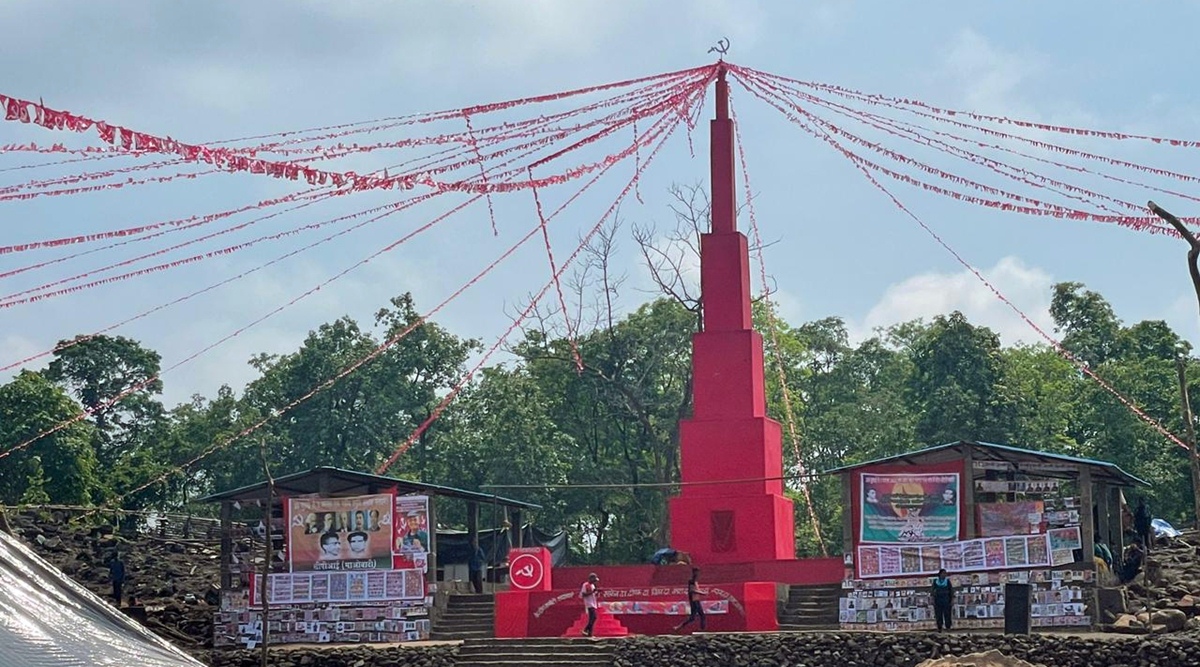
Deep in the forests of Bastar, a 64-foot-tall, red spire stands tall, towering over the canopy of the nearby trees. A memorial to a senior Maoist leader, it was inaugurated during the recent Shaheedi Saptah, a week-long annual programme organised by Maoists in Chhattisgarh’s Bijapur district.
The spire, a memorial for Ramakrishna or RK, a senior member of the banned CPI (Maoist) leader and head of the party’s Central Technical Committee, has come up deep inside a rebel stronghold, near the Telangana-Chhattisgarh border – one of the loudest signals in recent times from the Maoists amid claims by the central and state governments of their shrinking footprint in Chhattisgarh.
Photographs show the spire, the biggest such in the Left-Wing-Extremism-affected areas of the state, is flanked by two stage-like podiums and sheds.
Complete with generator sets and sound systems, this year’s Shaheedi Saptah celebrations were seen as an open challenge to the police forces.
Subscriber Only Stories
Sources said that while security forces monitored the preparations and week-long celebrations closely, with the area still out of bounds for the personnel, there was little they could do.
Maoist memorials are common in the region. Security forces claim to have demolished 43 memorials in the past five years, 24 of those in 2021 alone. But unlike the tower in Bijapur, the memorials spread across the jungles of Abujhmad are usually small.
Senior officers, however, dismissed the idea the Maoists had cocked a snook at them by building the massive structure. “The Maoists are acting out of desperation. They have always built these memorials. It is good for us, because this way their resources are being spent on useless propaganda, which we will destroy eventually,” said Bastar IGP Sundarraj.
Advertisement
Sources in the government claimed that when the Bhupesh Baghel-led government came to power in 2018, it inherited a grim Maoist situation. “By 2018, Maoism had affected two-thirds of the state, with their presence increasing in districts such as Mahasamund, Raigarh, Dhamtari and others. The government then began working on a three-pronged approach of vishwaas-vikas-suraksha (trust-development-security),” said an official privy to the matter.
As part of the approach, government sources said, more than 250 schools were re-opened, and close to 200 villages electrified. The government also plans to install more than 600 cellphone towers across Bastar. Two major bridges are being built in Bijapur and Dantewada.
While over 1,000 alleged Maoists were arrested in 2017 and 2018, the number fell to 494 in 2021 – a sign, sources said, of the government’s more sensitive approach towards local population.
Advertisement
According to state police data, 586 villages out of 2,710 shed their Maoist tag in the last four years, helping take Kondagaon off the Centre’s list of LWE-affected districts.
Much like the BJP government, the Congress government has been encouraging security camps, with the state opening 43 new camps since 2019. According to security officials, the camps have managed to shrink Maoist presence.
Newsletter | Click to get the day’s best explainers in your inbox
The optimism of the senior personnel, however, doesn’t reflect on the ground. According to sources, the presence of the camps in newer areas have turned the personnel into sitting ducks, with Maoists now conducting operations closer to the camps. Last week in Bijapur, Maoists looted a bus carrying food supplies to a CRPF camp.
This flies in the face of claims, both the ruling Congress and the BJP, of “ending” Maoism.
Advertisement
On Sunday, speaking in Raipur, CM Baghel, in the presence of the Home Minister Amit Shah, said the state had “come very close to ending Maoism”.
At another event the same day, Shah said, “If Chhattisgarh brings back the BJP, we will finish Maoism in the snap of our fingers.”